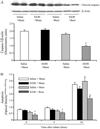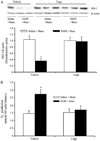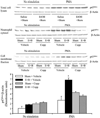Heme oxygenase-1 protects against neutrophil-mediated intestinal damage by down-regulation of neutrophil p47phox and p67phox activity and O2- production in a two-hit model of alcohol intoxication and burn injury
- PMID: 18453614
- PMCID: PMC3065786
- DOI: 10.4049/jimmunol.180.10.6933
Heme oxygenase-1 protects against neutrophil-mediated intestinal damage by down-regulation of neutrophil p47phox and p67phox activity and O2- production in a two-hit model of alcohol intoxication and burn injury
Abstract
Heme oxygenase-1 (HO-1) has been demonstrated to protect against tissue injury. Furthermore, HO-1 is also shown to be antioxidant. Our recent findings indicate that acute alcohol (EtOH) intoxication exacerbates postburn intestinal and lung tissue damage, and this was found to be neutrophil dependent. Because neutrophil-mediated tissue injury involves the release of superoxide anions (O(2)(-)), the present study examined the role of HO-1 in neutrophil O(2)(-) production following EtOH and burn injury. Furthermore, we investigated whether HO-1 antioxidant properties are mediated via modulation of p47(phox) and/or p67(phox) proteins. Male rats (approximately 250 g) were gavaged with EtOH to achieve a blood EtOH level of approximately 100 mg/dL before burn or sham injury (approximately 12.5% total body surface area). Some rats were treated with HO-1 activator cobalt protoporphyrin IX chloride (Copp; 25 mg/kg body weight) at the time of injury. On day 1 after injury, we found that EtOH combined with burn injury significantly increased neutrophil O(2)(-) production and p47(phox) and p67(phox) activation and decreased caspase-3 activity and apoptosis. This was accompanied with a decrease in neutrophil HO-1 levels. The treatment of animals with HO-1 activator Copp normalized neutrophil HO-1, O(2)(-), p47(phox), and p67(phox) following EtOH and burn injury. The expression of caspase-3, however, was further decreased in Copp-treated sham and EtOH plus burn groups. Moreover, Copp treatment also prevented the increase in intestinal edema and permeability following EtOH and burn injury. Altogether, these findings provide a new insight into the mechanism by which HO-1 regulates neutrophil O(2)(-) production and protect the intestine from damage following EtOH and burn injury.
Conflict of interest statement
The authors have no financial conflict of interest.
Figures








References
-
- Arturson G. Forty years in burns research: the postburn inflammatory response. Burns. 2000;26:599–604. - PubMed
-
- Fukushima R, Alexander JW, Gianotti L, Pyles T, Ogle CK. Bacterial translocation-related mortality may be associated with neutrophil-mediated organ damage. Shock. 1995;3:323–328. - PubMed
-
- Murphy TJ, Paterson HM, Mannick JA, Lederer JA. Injury, sepsis, and the regulation of Toll-like receptor responses. J. Leukocyte Biol. 2004;75:400–407. - PubMed
-
- Schwacha MG, Chaudry IH. The cellular basis of post-burn immunosuppression: macrophages and mediators. Int. J. Mol. Med. 2002;10:239–243. - PubMed
-
- Smith JW, Gamelli RL, Jones SB, Shankar R. Immunologic responses to critical injury and sepsis. J. Intensive Care Med. 2006;21:160–172. - PubMed
Publication types
MeSH terms
Substances
Grants and funding
LinkOut - more resources
Full Text Sources
Medical
Research Materials

